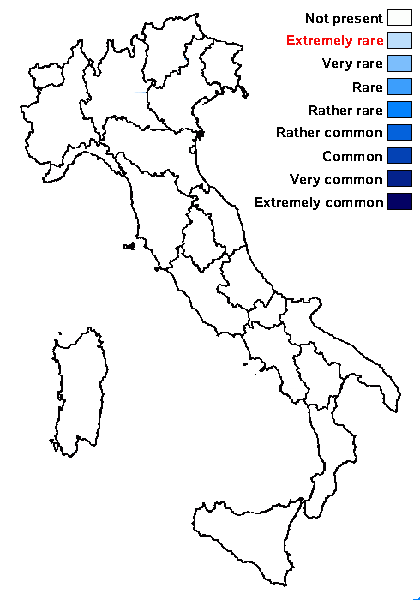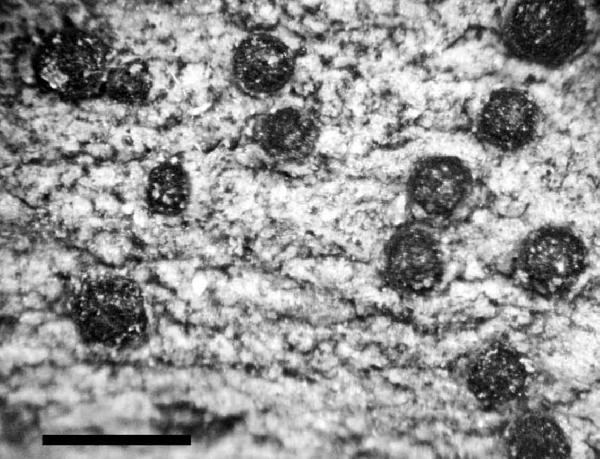Amandinea myrticola Giralt, van den Boom & Elix
Lichenologist, 43: 193, 2011.
Synonyms:
Distribution:
Description: Thallus crustose, episubstratic, continuous, very thin, smooth to minutely rugose, grey, without a distinct prothallus, often forming large patches. Medulla white, I-, without crystals. Apothecia at first immersed-erumpent and apparently lecanorine, being surrounded by an entire to cracked pseudothalline margin, soon becoming lecideine and sessile (but broadly attached), often contiguous, 0.1-0.2(-0.3) mm across. Disc dark brown to black, epruinose, at first concave, then flat to slightly convex; proper margin thin, soon excluded. Proper exciple more or less aethalea-type, 20-30 μm wide laterally, prosoplectenchymatous, with elongate, hyaline inner cells and short, brown outermost cells; epithecium brown; hymenium colourless, (30-)50-70 μm high, not inspersed with oil droplets; paraphyses capitate, the apical cells 3-5(-6) μm wide, with a dark brown cap; hypothecium dark brown, (30-)50-70 μm high. Asci 8-spored, clavate, Bacidia-type. Ascospores 1-septate brown, ellipsoid, straight or slightly curved, (10-)11-13.5(-15) x (4.5-)5–6(-6.5) μm, Physconia-type, not constricted at septum, faintly microrugulate, with ontogeny of type A (apical wall thickenings produced after septum formation). Pycnidia numerous, black, subimmersed, 0.1-0.2 mm across. Conidia thread-like, mostly strongly curved, c. 20 x 1 μm. Photobiont chlorococcoid. Spot tests: K-, C-, KC-, P-, UV-. Chemistry: without lichen substances.Note: this epiphytic species is hitherto known only from the coast of Portugal (Alentejo), growing on Myrtus and Pinus. The set of accompanying species reported by Giralt & van den Boom (2011) is strikingly similar to that found in undisturbed portions of the Tyrrhenian coasts of Italy (e.g. the Castelporziano Estate near Rome), so that the species should be looked for there.
Growth form: Crustose
Substrata: bark
Photobiont: green algae other than Trentepohlia
Reproductive strategy: mainly sexual
Most common in areas with a humid-warm climate (e.g. most of Tyrrenian Italy)
Taxon bound to maritime-coastal situations

Predictive model
Growth form: Crustose
Substrata: bark
Photobiont: green algae other than Trentepohlia
Reproductive strategy: mainly sexual
Most common in areas with a humid-warm climate (e.g. most of Tyrrenian Italy)
Taxon bound to maritime-coastal situations

Predictive model


